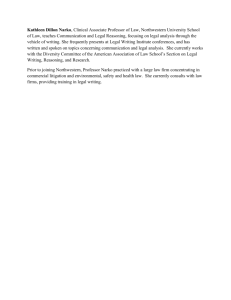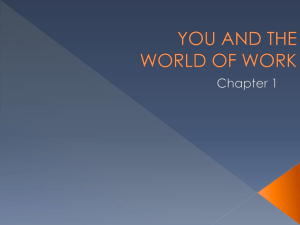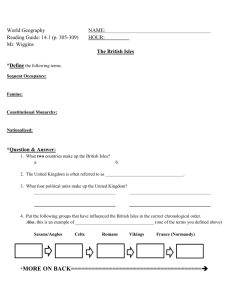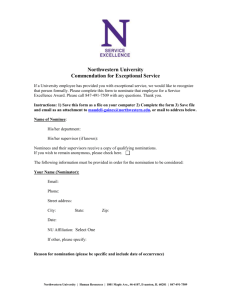6th Social studies 2nd 6 weeks, week 6.a
advertisement
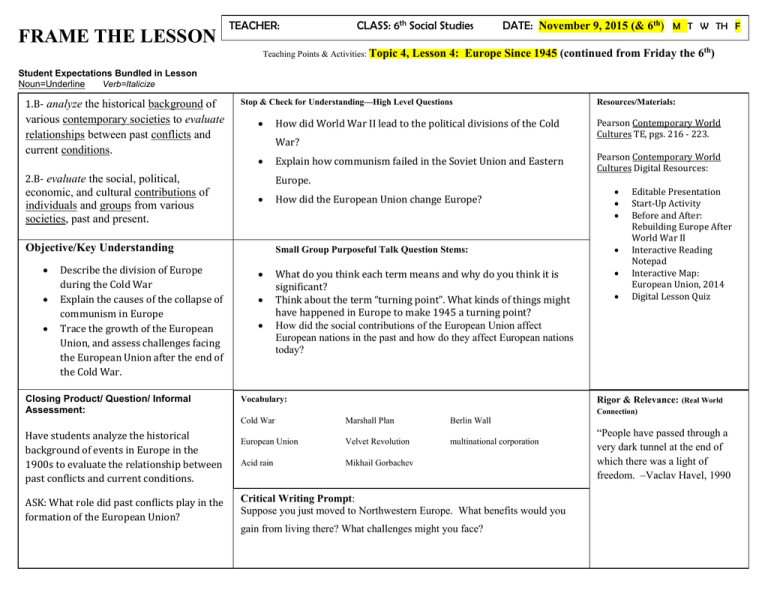
FRAME THE LESSON TEACHER: CLASS: 6th Social Studies DATE: November 9, 2015 (& 6th) M T W TH F Teaching Points & Activities Topic 1, Lesson 1: Geography of the US Teaching Points & Activities: Topic Resources/Materials: 4, Lesson 4: Europe Since 1945 (continued from Friday the 6th) Student Expectations Bundled in Lesson Noun=Underline Verb=Italicize 1.B- analyze the historical background of various contemporary societies to evaluate relationships between past conflicts and current conditions. Stop & Check for Understanding—High Level Questions War? 2.B- evaluate the social, political, economic, and cultural contributions of individuals and groups from various societies, past and present. Describe the division of Europe during the Cold War Explain the causes of the collapse of communism in Europe Trace the growth of the European Union, and assess challenges facing the European Union after the end of the Cold War. Explain how communism failed in the Soviet Union and Eastern Europe. Objective/Key Understanding How did World War II lead to the political divisions of the Cold Resources/Materials: Pearson Contemporary World Cultures TE, pgs. 216 - 223. Pearson Contemporary World Cultures Digital Resources: How did the European Union change Europe? Small Group Purposeful Talk Question Stems: What do you think each term means and why do you think it is significant? Think about the term “turning point”. What kinds of things might have happened in Europe to make 1945 a turning point? How did the social contributions of the European Union affect European nations in the past and how do they affect European nations today? Editable Presentation Start-Up Activity Before and After: Rebuilding Europe After World War II Interactive Reading Notepad Interactive Map: European Union, 2014 Digital Lesson Quiz : Closing Product/ Question/ Informal Assessment: Have students analyze the historical background of events in Europe in the 1900s to evaluate the relationship between past conflicts and current conditions. ASK: What role did past conflicts play in the formation of the European Union? Vocabulary: Rigor & Relevance: (Real World Connection) Cold War Marshall Plan Berlin Wall European Union Velvet Revolution multinational corporation Acid rain Mikhail Gorbachev Critical Writing Prompt: Suppose you just moved to Northwestern Europe. What benefits would you gain from living there? What challenges might you face? “People have passed through a very dark tunnel at the end of which there was a light of freedom. –Vaclav Havel, 1990 Engage Explore Explain Elaborate Evaluate Tell students that 1945 was a turning point in European history. Write the terms “Cold War,” “Iron Curtain,” and “Berlin Wall” on the board. What do you think each term means and why do you think it is significant? Think about the term “turning point. What kinds of things might have happened in Europe to make 1945 a turning point? Divide the class in to groups. Each group is to read a section and be prepared to discuss and share findings with the class. The Cold War in Europe Communism Collapses in Europe The European Union and Contemporary Europe Students are to read assigned sections and use the Note Taking Study Guide to help them take notes and understand the text as they read. The Cold War in Europe After World War II, Europe became divided between opposing communist and non-communist blocs. The Soviet Union took control of Eastern Europe. Western European countries and the US opposed the Soviet Union. Communism Collapses in Europe For more than three decades, communism dominated in Eastern Europe. However, weak economies there could not compete with stronger Western economies. Communist rule began to falter in the 1980s Strikes in Poland forced the government to allow free elections, which led to an end of Communist rule. Other countries followed and soon much of Eastern Europe was heading toward democracy. In 1989, the Berlin Wall came down and Germany was soon reunified. In 1991, the Soviet Union broke apart into 15 new nations. The European Union and Contemporary Europe To encourage European nations to live in peace, some nations began a free trade organization that eventually led to the formation of the European Union. By 20013, the EU had 28 member nations. Some of these members included Eastern European countries that could show they had democratic governments and market economies. Terrorism, immigration, and economic problems brought on by the 2008 recession remain serious issues today. Guided Reading and Discussion: The Cold War in Europe International Cooperation The Democratic West Unites Communists Control the East Communism Collapses in Europe Communism Fails A Democratic Revolution in Poland Revolution Spreads Germany Reunifies The European Union and Contemporary Europe The European Union Integrating the East International Issues Energy and the Environment Consider using the Digital Lesson Quiz for this lesson; students will be offered automatic remediation or enrichment based on their score. The following questions may also be used to assess learning. 1. How did World War II and the Cold War contribute to recent economic challenges in Europe? 2. How did Solidarity make a social contribution to European society? 3. Why do you think Mikhail Gorbachev supported democratic reforms? How did these reforms contribute to his government’s collapse? 4. What events led to the formation of the European Economic Community, and how did it become the European Union? 5. Do you think the European Union has benefited Europeans? Why or why not? FRAME THE LESSON Student Expectations Bundled in Lesson Noun=Underline Verb=Italicize 9B- compare and contrast free enterprise, socialist, and communist economies in various contemporary societies, including the benefits of the U.S. free enterprise system 10A- define and give examples of agricultural, wholesale, retail, manufacturing (goods), and service industries Objective/Key Understanding: : CLASS: 6th Social Studies LESSON DATE: November 10-11, 2015 TEACHER: Describe the systems of government and economies of the United Kingdom and Ireland. Evaluate Scandinavia’s cradle-to-grave system and describe its economy and how geography affects the economy Explain the impact of technology and immigration on life in Northwestern Europe. M T W TH F Stop & Check for Understanding—High Level Questions Topic 4, Lesson 5: Northwestern Europe Today (1/2 Day of Instruction; 2 Days for CBAs; END OF 6-Week period) Teaching Points & Activities: Resources/Materials: What impact does membership in the EU have on the United Kingdom and Ireland? What three industries developed because of Scandinavia’s geography and natural resources? What are the challenges facing immigrants to Northwestern Europe? What do you think is Queen Elizabeth’s role in British government and life? Why do you think the United Kingdom maintains a monarchy? Vocabulary: Vocabulary: Parliament gross domestic product Pearson Contemporary World Cultures Digital Resources: Small Group Purposeful Talk Question Stems: Constitutional monarchy Cradle-to-grave system Vocabulary: Cultural borrowing Pearson Contemporary World Cultures TE, pgs. 224 – 232. Elizabeth II Closing Product/ Question/ Informal Assessment: Critical Writing Prompt: How did becoming a member of the European Union help Ireland? How are the relationships to the European Union of the United Kingdom and Ireland similar? Editable Presentation Start-Up Activity Interactive Map: One Nation, Four Countries Interactive Gallery: Northwestern Europe’s Economies Digital Activity: Cultural Borrowing in Northwestern Europe Digital Lesson Quiz Rigor & Relevance: (Real World Connection) Every country has an economic system that helps them run their company. Engage Tell students that some countries in Europe still have monarchs, such as Queen Elizabeth II of the United Kingdom. She is the head of state of the UK, but her role is mostly symbolic. Parliament, which is elected by voters, governs the country. Queen Elizabeth is the eldest daughter of King George VI. She has reigned since his death in 1952, when she was 25 years old. Tell Students that in this lesson they will learn about life in Northwestern Europe today, including how the countries here structure their governments. Explore Divide the class in to groups. Each group is to read a section and be prepared to discuss and share findings with the class. The United Kingdom & Ireland The Scandinavian Countries Life in Northwestern Europe Students are to read assigned sections and use the Note Taking Study Guide to help them take notes and understand the text as they read. Explain The United Kingdom & Ireland The United Kingdom consists of England, Wales, Scotland, and Northern Ireland. Its government is a constitutional monarchy. Scotland has its own Parliament and government, Wales can pass laws that affect Wales, and Northern Ireland has a separate assembly. Ireland is an independent nation. It is a republic with a parliamentary democracy. Both Britain and Ireland have strong economies and are members of the European Union. The Scandinavian Countries The countries of Scandinavia – Denmark, Finland, Iceland, Norway, and Sweden – are known for governments that make more economic decisions for their citizens than is the case in a free enterprise economy. This makes their economies similar to a socialist economic system. Scandinavian governments provide their citizens with healthcare, childcare, and education throughout their life in what is called a cradle-to-grave system. People support this system by paying high taxes. Scandinavia’s economy is also affected by its coastline and forests, which supply the fishing and lumber industries. The economies of these countries rely on multinational corporations, high-technology industries, and exports, including mobile telephones from Finland and oil taken from the North Sea. Life in Northwestern Europe People living in Northwestern Europe depend on technology. Many of the region’s largest cities are capital cities, and they provide people with places to live and work and experience history and culture. As a region with many immigrants, people take part in cultural borrowing. Elaborate The United Kingdom & Ireland British Government Prosperity and Partnerships Economic Challenges A Tourist Destination The Scandinavian Countries Governments and Economies Fish, Forests, and Phones Life in Northwestern Europe Living with Technology Living in Cities Living Together Evaluate Consider using the Digital Lesson Quiz for this lesson; students will be offered automatic remediation or enrichment based on their score. The following questions may also be used to assess learning. 1. 2. 3. 4. 5. How is Britain’s constitutional monarchy different from other democracies? How has Britain’s recovery compared to Ireland’s since the 2008 recession? What makes Norway’s government and economy different from other Scandinavian countries? What issues do you predict new immigrants to this region might face? Why might this region attract immigrants anyway? How has Ireland’s economy changed since the 1970’s? FRAME THE LESSON TEACHER: CLASS: 6th Social Studies Teaching Points & Activities: Topic DATE: November 12-13, 2015 M T W TH F 4, Lesson 6: Student Expectations Bundled in Lesson Noun=Underline Verb=Italicize 10C- identify and describe the effects of government regulation and taxation on economic development and business planning. 15F- identify and explain examples of conflict and cooperation between and among cultures. Stop & Check for Understanding—High Level Questions Why might a smaller West Central European country want to be part of the European Union? How do you think immigrants are affecting French culture? What makes Switzerland’s role in Europe special? : Explain how the European Union affects different countries in West Central Europe today and demonstrates cooperation between cultures. Compare and contrast the societies of France, Belgium, Luxembourg, and the Netherlands Explain how the legacies of World War II and the Cold War continue to affect Germany, and trace the ways Austria and Switzerland have dealt with new challenges since World War II. Pearson Contemporary World Cultures TE, pgs. 233240. Pearson Contemporary World Cultures Digital Resources: Objective/Key Understanding Resources/Materials: Small Group Purposeful Talk Question Stems: Some critics say that larger countries are more powerful in the EU government than smaller countries. Based on what you have read, do you agree or not? Explain. What is an example of conflict between and among the cultures of France? Vocabulary: Editable Presentation Start-Up Activity Interactive Chart: EU Cooperation Interactive Reading Notepad Interactive Chart: German Exports Digital Lesson Quiz Rigor & Relevance: (Real privatization polders reunification Berlin Wall fragile recruit gross national product Closing Product/ Question/ Informal Assessment: Critical Writing Prompt: What are the goals of the European Union? Have students write three statements about Italy, Greece, or Spain that demonstrate what they already know about how the contributions of these countries have affected modern life. World Connection) Germany relies heavily on foreign markets. Do you think any countries are selfsufficient? Engage Explore Tell students that in this lesson they will learn about West Central Europe today, including the countries of France and Germany and their neighbors. Tell students that Paris is France’s cultural and economic center, and it is a world center of art and learning. Germany has a strong industrial economy and is famous for its music, art, and literature. Tell students to write down three questions that they have about France and Germany and their economies, cultures, or politics. As students complete the lesson, have them compare France and Germany and write down answers to their questions. Divide the class in to groups. Each group is to read a section and be prepared to discuss and share findings with the class. West Central Europe and the European Union France and the Low Countries Germany, Austria, and Switzerland Students are to read assigned sections and use the Note Taking Study Guide to help them take notes and understand the text as they read. Explain Elaborate West Central Europe and the European Union Countries belonging to the European Union demonstrate cooperation. They benefit from a single market system and have learned to work together to overcome language barriers and national interests. Three countries in the region – Switzerland, Liechtenstein, and Monaco- have not joined the EU. Germany and France are large and powerful members of the EU. Generally the countries of this region are wealthier than the countries of southern and eastern Europe. There is some tension in the EU between the richer and poorer countries. France and the Low Countries France, Belgium, Luxembourg, and the Netherlands all play major roles in the EU. France has a strong government and economy, although its high taxes and restrictive business regulations have had a negative effect on the economy. France’s tourism industry remains strong, but immigration is a major issue for the country. Belgium is home to the EU. Its economy relies onh trade, while Luxembourg relies on banking and media. The Netherlands is a sea-trading nation. Germany, Austria, and Switzerland The reunification of Germany ended the split between East and West Germany. Germany’s history includes its crimes during World War II, which resulted from extreme nationalism. Today the government encourages education, tolerance, and open-mindedness, but conflict with immigrants still occurs. Once a large empire, Austria has become a country with a prosperous democracy due to tourism. Because of tis neutrality, Switzerland has had poor relationships with international organizations, including the United Nations, which it did not join until 2002. ~Guided Reading and Discussion: West Central Europe and the European Union The Goals of the European Union European Union Membership The Global Recession Causes Divisions France and the Low Countries The French Economy Paris: City of Light Immigration in France Belgium: EU Headquarters Landlocked Luxembourg The Netherlands: A Fragile Balance Germany, Austria, and Switzerland German Reunification German Culture Immigration in Germany Austria Switzerland Evaluate Consider using the Digital Lesson Quiz for this lesson; students will be offered automatic remediation or enrichment based on their score. The following questions may also be used to assess learning. 1. What are some advantages to having a single currency throughout the most of the EU? 2. Why was Germany able to make such a quick recovery from the recession? 3. What was the result of privatization in France? 4. What does the creation of polders suggest about the Netherlands population density, or the amount of people who live in a certain area of land? Explain 5. What is something German leaders have learned from the country’s past?
